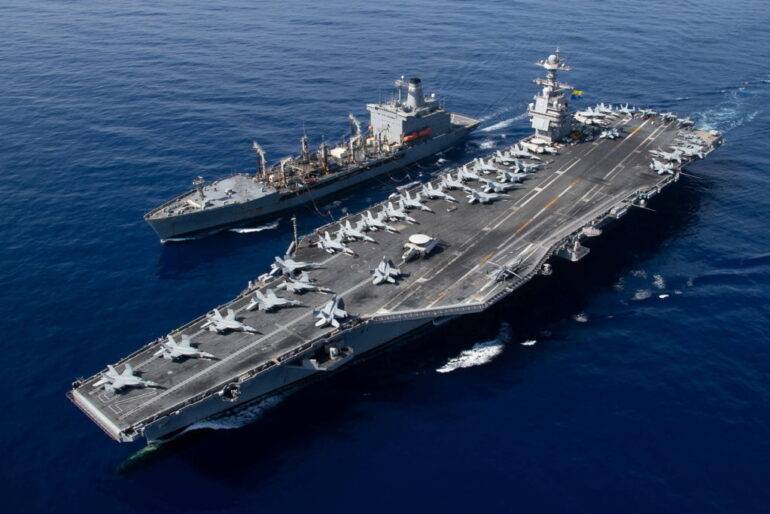In a bold move that’s rattling governments across Latin America, the U.S. Pentagon has ordered the deployment of the USS Gerald R. Ford—the world’s largest aircraft carrier—and its strike group to the Caribbean. Announced on Friday, this escalation aims to ramp up efforts against drug-trafficking networks but has ignited fears of a broader conflict, with Venezuelan President Nicolás Maduro accusing the Trump administration of plotting “a new eternal war.”
The carrier, currently stationed in the Mediterranean, will bring a surge of firepower to the region: nearly 4,500 sailors, nine squadrons of fighter and surveillance aircraft, and at least five accompanying destroyers. Pentagon spokesman Sean Parnell described the mission as a way to “enhance and augment existing capabilities to disrupt narcotics trafficking and degrade and dismantle transnational criminal organizations,” or TCOs. Already, more than 6,000 U.S. sailors and Marines are operating eight warships in the area, marking an unusually heavy military presence in the Western Hemisphere.
This deployment caps a whirlwind of U.S. military actions that began in early September under President Donald Trump. Campaigning on promises to avoid endless foreign wars, Trump instead launched targeted strikes on boats suspected of smuggling drugs into the U.S. To date, these operations have destroyed at least 10 vessels and killed 43 people, according to tallies from U.S. figures reported by AFP. The pace has quickened dramatically—from one strike every few weeks to three in a single week—expanding from the Caribbean to the eastern Pacific, near major cocaine producers like Colombia.
The latest raid, conducted overnight Thursday, targeted a boat linked to the Venezuelan gang Tren de Aragua, killing six people. Defense Secretary Pete Hegseth, speaking on social media, likened the traffickers to Al-Qaeda: “If you are a narco-terrorist smuggling drugs in our hemisphere, we will treat you like we treat Al-Qaeda. Day or NIGHT, we will map your networks, track your people, hunt you down, and kill you.” Tren de Aragua, designated a foreign terrorist organization by the Trump administration, has been tied to at least two of the strikes and is blamed for fueling violence in U.S. cities.
Yet, as the U.S. intensifies its campaign—drawing parallels to the post-9/11 war on terror—evidence linking the targeted boats to drug smuggling remains scarce. Trump has declared cartels “unlawful combatants,” invoking the same legal powers used against jihadists, and dismissed the need for a congressional war declaration. “The land is going to be next,” he warned Thursday during a White House roundtable, comparing the groups to the Islamic State. Lawmakers from both parties, however, are raising alarms. Democratic Sen. Andy Kim, a former Pentagon adviser, called the operations unprecedented and unpredictable: “We have no idea how far this is going… Is it going to be boots on the ground? Is it going to be escalatory in a way where we could see us get bogged down for a long time?”
A Powder Keg in the Caribbean
The buildup has supercharged long-simmering U.S.-Venezuela tensions. Maduro, facing U.S. narcoterrorism charges, views the moves as a pretext for regime change. “They promised they would never again get involved in a war, and they are fabricating a war that we are going to prevent,” he declared on state television late Friday. Earlier this week, he boasted of Venezuela’s defenses, including 5,000 Russian man-portable surface-to-air missiles, and praised nationwide coastal drills that mobilized heavy weapons along 1,200 miles of shoreline.
U.S. shows of force have only heightened the stakes. Last week, B-52 bombers circled off Venezuela’s coast; on Thursday, a B-1B bomber flew perilously close offshore, per flight tracking data. Complicating matters is Tropical Storm Melissa, stalled in the central Caribbean and threatening to balloon into a hurricane, which could disrupt naval movements.
The ripple effects extend beyond Caracas. Colombia’s left-leaning President Gustavo Petro, a vocal critic of the strikes whom he has called “murder,” faced U.S. Treasury sanctions Friday—along with his wife and son—for allegedly enabling drug flows. Petro has accused Trump of overstepping into sovereign affairs. Meanwhile, Brazil, a regional heavyweight, has sounded the alarm through Celso Amorim, a top advisor to President Luiz Inácio Lula da Silva. “We cannot accept an outside intervention because it will trigger immense resentment,” Amorim told AFP. “It could inflame South America and lead to radicalization of politics on the whole continent.”
Experts echo these worries. Elizabeth Dickinson, a senior analyst for the International Crisis Group in the Andes, argues that drugs are “the excuse” for a deeper U.S. agenda. “The messaging here is that the U.S. is intent on pursuing specific objectives. And it will use military force against leaders and countries that don’t fall in line,” she said. Not all voices in Washington agree; Republican Rep. Mario Diaz-Balart of Florida praised the approach as “about time,” noting Trump’s aversion to full-scale war but readiness for precision strikes.
Broader Implications for a Volatile Hemisphere
As the USS Gerald R. Ford steams toward the Caribbean—its exact arrival timeline unclear amid scattered destroyer deployments—the question looms: How far will the Trump administration push? The carrier’s repositioning from Europe to Latin America signals a strategic pivot, potentially sidelining NATO exercises like the recent Neptune Strike 2025 in the North Sea. For Latin America, already grappling with cartel violence and economic woes, the specter of U.S. intervention evokes painful memories of past meddling.
Trump’s drug war, framed as a hemispheric defense against fentanyl and cocaine floods, has won domestic applause but risks alienating allies. With Maduro digging in and neighbors on edge, the region braces for what could evolve from boat raids to something far more explosive. As Hegseth put it, the U.S. is hunting narcos “day or night.” But in the shadow of this carrier’s approach, many wonder: At what cost to peace?
